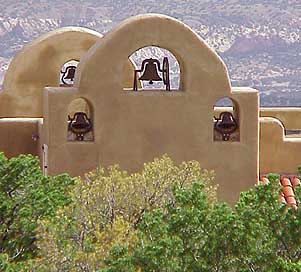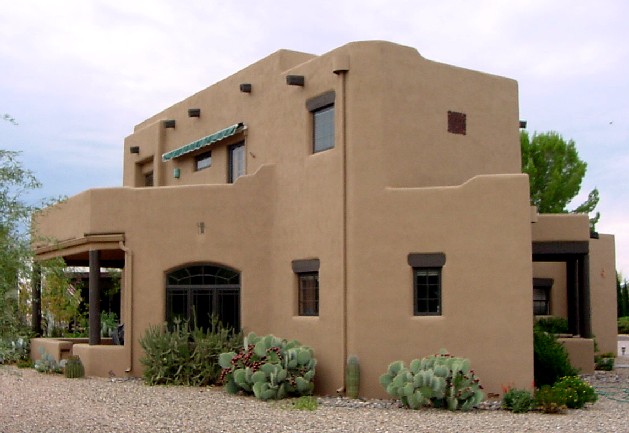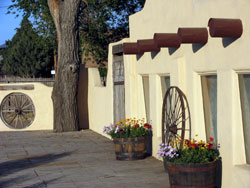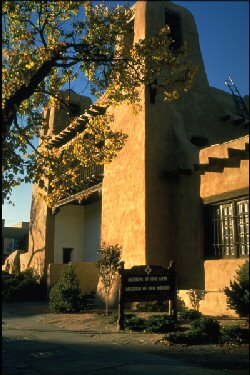|
Early morning light catches the peaks of the Sangre de
Cristo range. The earth begins to glow.
As sunrise pushes back the night, the town below is
revealed as a patchwork of brown, pink and beige.
The uniform style and colors of the buildings in the
town induce a sense of being welcomed and even embraced.
The word connection comes to mind.
To see it is to feel it. The long, clean, gently
broken horizontal lines of the clustered, low-slung
Pueblo/Spanish-style buildings produce a network of
intersecting lines. They are like cords of energy
binding people to the earth and linking them to the
emerging daylight.
For a moment, you think, "This can't be America,
1998. I've time-traveled."
And then you see the cars and remember that time
travel hasn't been invented.
This is here and this is now, but this is also Santa
Fe, a town so easy on the eyes and soothing to the soul
you want to call it natural, traditional, authentic,
real.
And yet it's so totally, completely . . . artificial.
Structures with a design borrowed from Native America
and Spanish America house businesses ardently
Anglo-American: dry cleaners and dime stores, art
galleries and restaurants.
The Euro-Americans who
dominate the region are not here to live like Native
Americans but like modern global citizens in "let's
pretend" surroundings.
Certainly, it's not real to surround yourself with
out-of-date architecture and live shut away from the
strip-mall, fast-food higgledy-piggledy world of today?
This is not authenticity - this is escape.

Face it: If the Disney organization built a
SouthwestLand, it would look like Santa Fe with theme
rides.
In fact, the entire enterprise called Santa Fe was
decreed from its modern origins as a kind of
SouthwestLand. In The Myth of Santa Fe: Creating a
Modern Regional Tradition (University of New Mexico
Press, $39.95), author Chris Wilson explains that
the
"natural" look of present-day Santa Fe is the result of
a conscious strategy to attract tourists.
At the turn of the 20th century, Santa Fe was sinking
in financial stagnation, and city fathers saw the
creation of a historical throwback in the middle of the
desert as potential salvation.
"By 1920, an unwritten consensus formed that all new
buildings should employ the Pueblo-Spanish style," with
some Territorial additions in the 1930s, Wilson writes.
Ironically, this required a reversal of trends. In
the late 19th century, Santa Feans had built with adobe
and disguised the result as more-acceptable brick or
frame structures. Now,
everything had to be disguised as
adobe, even buildings made with brick. A city ordinance
in 1957 confirmed by law what had long been in effect by
common agreement: that Santa Fe would, to the greatest
degree possible, look as it did before 1860, when the
increasing Anglo population brought East Coast-style
buildings to the area.

Is Santa Fe for real? Not in the sense that
architects w ould use "real."
"Honest use of materials," the famous maxim of modern
architecture, is violated by Santa Fe's architectural
raison d'etre: adobe in looks if not in actuality.
The authentic item is easy to make. Go to tiny
Tesuque Pueblo (population 425) most days in summer, and
you'll find laborers making and building with adobe
bricks. The mud is mixed with hay in a tumbler, pressed
and cut into squares and set out to dry.
The drying takes anywhere from a few days to a few
weeks, depending on humidity.
Then the buildings go up. A small, rectangular home
was under construction when I stopped by - simplicity of
material matched by simplicity of design. This is
natural and real and second nature to the people who
have lived in Tesuque Pueblo for centuries.
For the people to the south in Santa Fe, it's exotic.
So they come - some to stare, some to stay - and they
don't seem to mind or even notice the artificiality of
their surroundings.
Pianist-composer Marc Neikrug came to live in Santa
Fe in 1990. He's now artistic director of the
prestigious Santa Fe Chamber Music Festival. It was
Neikrug who first mentioned to me The Myth of Santa Fe,
acknowledging the town's fabrication as a sort of
high-class tourist mecca. So, why, of all the places
that he, as musician, might have settled, did Neikrug
choose to move here?
"Simply because it is the most beautiful place I've
ever been," he said.
And he meant the "artificial" town ambience right
along with the elevating natural environment.

Artists of every discipline have agreed with
Neikrug's
assessment. First came the painters, settling
in Santa Fe and its smaller mirror image to the north,
Taos. John Sloan, Marsden Hartley, Ernest L.
Blumenschein, Victor Higgins and others explored the
region in the teens and '20s, painting the shapes of the
mountains and clouds. Georgia O'Keeffe arrived in 1929,
synthesized all that had come before and developed the
iconic vision of earth tones, cow skulls and sky-blue
vistas many carry with us as "New Mexico."
Photographers followed. Ansel Adams claimed the
landscape for his own, using his famous technical
methods to capture the richness of New Mexican light in
black and white.
Then came the writers. D.H. Lawrence found the Indian
energy in affinity with his own sense of the life force;
his ashes are interred at Taos.
Novelist Willa Cather portrayed the nobility of Santa
Fe's 19th-century Archbishop Lamy, whose faith and will
forged the building of Santa Fe's Romanesque St. Francis
Cathedral, in Death Comes for the Archbishop.
The moneyed, New England-born poet Witter Bynner made
Santa Fe home from 1922 to his death in 1968. Artificial
or real, Santa Fe to him was a spiritual preserve in a
materialist world. He celebrated this in his poem Santa
Fe:
Among the automobiles and in a region
Now Democratic, now Republican,
With a department store, a branch of the Legion,
A chamber of commerce and a moving van,
In spite of cities crowding the Trail,
Here is a mountain town that prays and dances
With something left, though much besides may fail,
Of the ancient faith and wisdom of St. Francis.
The major religion of the area in recent history has
been Roman Catholicism, but the spirituality of the
place is ecumenical. The Anasazi, perhaps ancestors to
the Pueblo Indians, lived in the area for a thousand
years before the Spanish founded Santa Fe in 1609-1610,
and Native American ceremonies still thrive in the
surrounding pueblos. New Age psychics also abound.
The arts continue to be important. Classical music is
big business in the summer, with the Santa Fe Opera
(505-986-5900) and Santa Fe Chamber Music Festival
(505-983-2075) playing to consistently sold-out houses
for months.

Canyon Road near the center of Santa Fe is crowded
with galleries showing the work of the latest hopefuls
to succeed O'Keeffe and company. O'Keeffe's work is now
the stuff of one of Santa Fe's most visited shrines, the
Georgia O'Keeffe Museum (505-685-4539).
The current energy of Santa Fe's visual arts is most
readily visible in 3-D at Shidoni (505-988-8001), a
sculptural center in the town of Tesuque, five miles
north of town.
Its sprawling sculpture garden displays whimsical and
realistic work of massive scale. At certain times,
visitors can watch bronze poured and cast.
The strategy to make Santa Fe attractive to tourists
has certainly worked. The 4,000-plus hotel rooms here
can barely accommodate summer visitors. Tourists pay
close to $100 million annually just for accommodations.
Some would say it has worked too well, with Santa
Fe-style in architecture and dress and food having
become a coyote-ridden cliche.
Yet humans are fabricators, and everything we make is
artificial. Towns and cities of any character are myths
created by people to suit their aesthetic or commercial
or political needs.
Manhattan is a myth. So is Seattle. Bank One Ballpark
could be the beginning of a Phoenix myth.
We Americans tend to confuse real with practical,
arming ourselves with a prejudice against the beautiful
and the creative.
Perhaps the best way of being real is
being artificial. It works for Santa Fe. |

